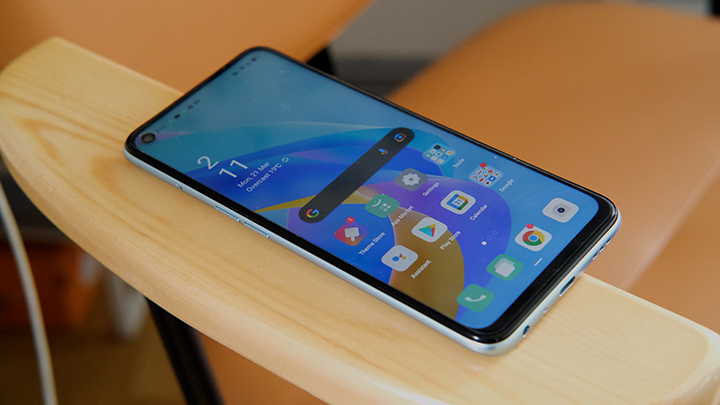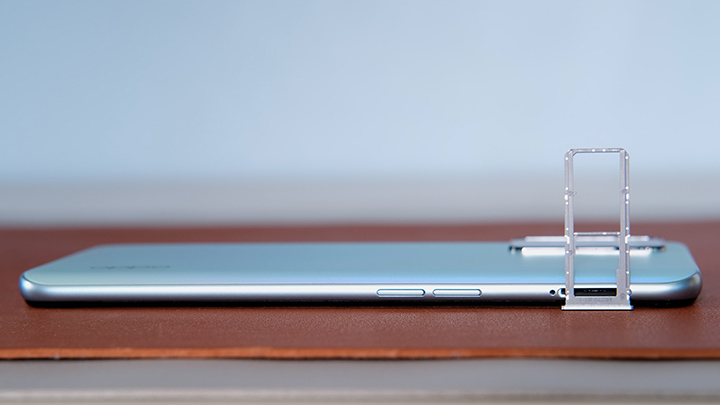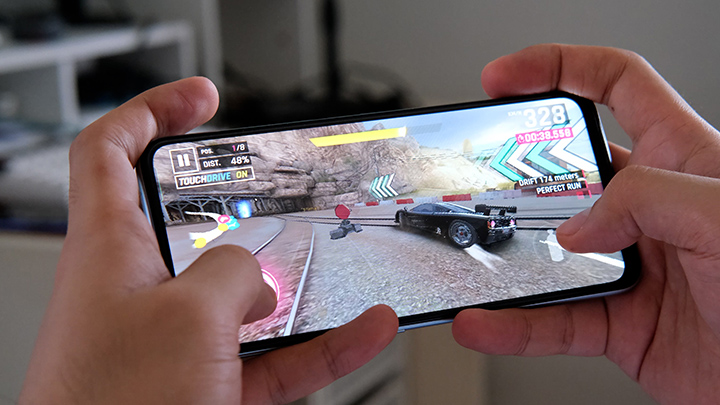OPPO A76 is now officially released in the Philippines, sporting a 6.56-inch screen with a 90Hz refresh rate, a Snapdragon 680 4G chipset, and a 5,000mAh battery with 33W SuperVOOC. At the suggested retail price of Php11,999, is it worth it? Find out in this full review.

Table of Contents
Now let’s talk about the design. Just like most OPPO mid-range phones today, the A76 has a simple but solid design with a smooth matte finish for the back panel that features a charming OPPO Glow technology.
Also here at the back, you’ll find the protruding dual camera setup at the top-left corner. We’ll get to the details of that later.

It is available in Glowing Black and Glowing Blue colorways which is what we have. We love how this design is fingerprint and dust resistant. However, do take note that the back panel is slightly slippery, so we suggest using the provided silicone case.
Holding the phone, it feels very thin and has the right amount of weight. Also, this device is slim, making it pretty comfortable to grip and easy to slip into pockets.

Flipping to its screen, you will be confronted by a 6.56-inch IPS display with slim bezels but a slightly thicker chin. There’s also a large punch-hole on the upper left for the 8MP selfie camera, while found at the top of the display by the bezel is the earpiece.

On the left side are the volume rocker and just above it is the triple-card tray for two nano-sized SIM cards and a microSD card.

Meanwhile on the right is the power/lock button that doubles as a fingerprint scanner. The buttons are made of plastic yet it’s firm and clicky. It’s also easily reachable since it’s placed near the middle of the frame.

Up top is the secondary noise-canceling microphone; while down at the bottom, there’s the 3.5mm headphone jack, primary microphone, USB-C port, and the loudspeaker.
Taking a closer look at the display, we get a sizable 6.56-inch IPS LCD display with a 90Hz refresh rate, 1612 x 720 resolution, and pixel density of 269ppi. The 180Hz touch sampling provides good responsiveness and is very useful in usage scenarios such as playing games. Unfortunately, it’s HD+ only.

Well, the display is still bright enough to use indoors and outdoors, colors are vibrant and offers good viewing angles, thanks to its sizable screen.

As usual, the display is customizable, from screen color temperature, to screen color mode, to dark mode settings that let you set how dark you want to go. Also in the display settings, you can manage the screen color temperature, switch between the Gentle or Vivid color mode. As for refresh rate, you can opt to use it on the high refresh rate, drop down to 60Hz to conserve battery life. There’s no Always-on display here like the OPPO A74 and OPPO A95.

Audio-wise the phone has a single downward-firing speaker that emphasizes the mids for better phone call reception, but the rest of the sound profile is nothing to write home about. The audio jack has mercifully stayed in this phone, so you can use your favorite pairs when you want a better sound experience.

Unlike its predecessor which has a triple rear camera setup, this phone features a dual rear setup that consists of a 13MP main camera, and 2MP for mono. Meanwhile, for selfies, you get an 8MP shooter.
Quality-wise, in standard mode, daylight photos come out fairly good, details are present, while the dynamic range and color reproduction can be further improved. Also, edge detection in portrait shots needs improvement with the background blur. To get more vibrant colors, we suggest activating the AI mode.
There’s no ultrawide and macro mode available here, but you can zoom in to 2x, and up to 6x and for results, don’t expect too much.
Meanwhile for low light shots, details are okay but with a lot of noise and can be blurred sometimes. It’s still usable, yes, but it needs just a little tweaking in a photo app or editor.
For selfies, under direct sunlight, it has a tendency to become overexposed, but with proper lighting, selfies may appear fantastic, with great details and colors. If you choose to utilize the beauty mode, you may customize it quite a bit.
For videos, users can shoot up to 1080p videos, and as expected quality is so-so.
It’s also noticeable that it lacks some stabilization, so better use a tripod or gimbal.
Running the software department is ColorOS 11.1 that’s based on Android 11. And like previous ColorOS versions, there are tons of customization options here where you change icon styles, app layout, fingerprint style, change font and colors. There’s also an app drawer option in the settings, and you can easily adjust the navigation buttons the way you want them to be arranged.

It also comes with a few bloatware and tons of pre-installed apps like Facebook, and Messenger, which can be removed after setup, as usual.
Storage-wise, out of the 128GB that we get, we’re left with 108GB out of the box, which is still more than enough for casual users.
Under the hood, the OPPO A76 is powered by a Qualcomm Snapdragon 680 4G SoC, with a Adreno 610 GPU and 6GB of RAM (+5GB expansion). The day-to-day usage of the A76 is pretty decent. It can handle basic tasks like streaming, web browsing, messaging and calls. However, launching apps and multitasking is quite slow.

When it comes to gaming, the phone can hold itself while playing Asphalt 9 on the lowest graphics settings, but don’t expect to get a smooth performance as the phone can stutter especially when there are many things happening on screen and even if that’s not the case the images being put out is still not as good as others.
If you’re interested in numbers, check out the benchmarks scores that we got:
When it comes to biometrics and security, you can unlock the device via facial recognition and the side-mounted fingerprint scanner. Surprisingly, both work fast.
As for connectivity, this OPPO A76, same with its predecessor, has the basic features such as WiFi, Bluetooth, GPS, FM Radio and 4G LTE for connectivity.

When it comes to battery, the device packs a large 5,000mAh capacity with 33W superVOOC. This device can last at least a day if you’re not a heavy user and takes no more than an hour to charge up from 0 to 100%.
In our standard video loop test, where we keep a 1080p movie in loop at 50% brightness, 0% volume, and airplane mode turned on. The device lasted for surprisingly 27 hours and 15 minutes. That’s pretty good.

At Php11,999, the OPPO A76 seems to be a downgrade from its predecessor, the OPPO A74, with the latter’s AMOLED display, an in-display fingerprint scanner, and better cameras in general.
However, if you don’t care about those features, this phone gives you a better processor, a stylish design, and faster charging thanks to its superVOOC charging support.
So, will you be getting this phone? Let us know in the comments.
OPPO A76 specs:
6.56-inch HD+ (1612 x 720) IPS display, 269ppi
90Hz refresh rate
Qualcomm Snapdragon 680 4G SoC
Adreno 610 GPU
6GB RAM (+5GB expansion)
128GB storage
microSD card support
Dual-rear cameras:
• 13MP main
• 2MP mono
8MP front camera
Dual-SIM
4G LTE
WiFi 802.11 a/b/g/n/ac
Bluetooth 5.0
GPS, A-GPS, GLONASS, GALILEO, BDS, QZSS
USB-C
3.5mm audio jack
Fingerprint scanner (side)
ColorOS 11.1 (Android 11)
5,000mAh battery w/ 33W charging
164.4 x 75.7 x 8.4 mm
189 g
Glowing Black, Glowing Blue

YugaTech.com is the largest and longest-running technology site in the Philippines. Originally established in October 2002, the site was transformed into a full-fledged technology platform in 2005.
How to transfer, withdraw money from PayPal to GCash
Prices of Starlink satellite in the Philippines
Install Google GBox to Huawei smartphones
Pag-IBIG MP2 online application
How to check PhilHealth contributions online
How to find your SIM card serial number
Globe, PLDT, Converge, Sky: Unli fiber internet plans compared
10 biggest games in the Google Play Store
LTO periodic medical exam for 10-year licenses
Netflix codes to unlock hidden TV shows, movies
Apple, Asus, Cherry Mobile, Huawei, LG, Nokia, Oppo, Samsung, Sony, Vivo, Xiaomi, Lenovo, Infinix Mobile, Pocophone, Honor, iPhone, OnePlus, Tecno, Realme, HTC, Gionee, Kata, IQ00, Redmi, Razer, CloudFone, Motorola, Panasonic, TCL, Wiko
Best Android smartphones between PHP 20,000 - 25,000
Smartphones under PHP 10,000 in the Philippines
Smartphones under PHP 12K Philippines
Best smartphones for kids under PHP 7,000
Smartphones under PHP 15,000 in the Philippines
Best Android smartphones between PHP 15,000 - 20,000
Smartphones under PHP 20,000 in the Philippines
Most affordable 5G phones in the Philippines under PHP 20K
5G smartphones in the Philippines under PHP 16K
Smartphone pricelist Philippines 2024
Smartphone pricelist Philippines 2023
Smartphone pricelist Philippines 2022
Smartphone pricelist Philippines 2021
Smartphone pricelist Philippines 2020